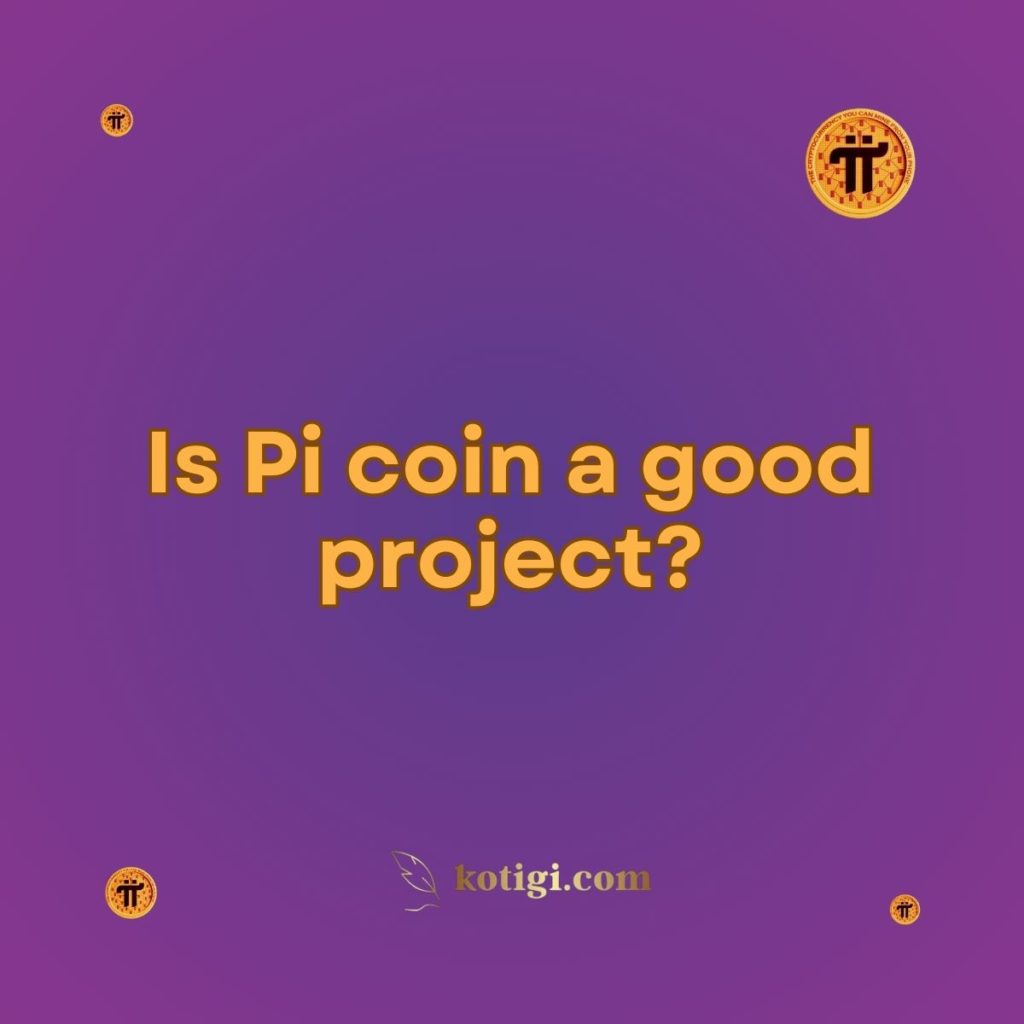
Is Pi coin a good project?
Pi Network is considered a promising project by many due to its innovative mobile-based mining model and growing user base. However, its future success hinges on the transition to an open mainnet, adoption by businesses and consumers, and regulatory compliance. Like any cryptocurrency project, it carries risks, and its long-term value will depend on market demand, utility, and widespread adoption.
Introduction
Pi Network has become a highly discussed cryptocurrency project, particularly because of its unique approach to mining. Unlike traditional cryptocurrencies that require specialized hardware, Pi allows users to mine using their smartphones. With millions of users participating in its mining process, many people are curious about whether Pi Coin is truly a good project or just another cryptocurrency hype. This article dives into Pi’s unique features, the opinions of experts, and the potential for long-term success to assess whether Pi is worth considering as a promising crypto project.
What Makes Pi Network Unique?
Mobile-Based Mining
One of Pi Network’s standout features is its ability to allow users to mine cryptocurrency via their mobile phones. This concept differs greatly from traditional mining methods like those used in Bitcoin, which require energy-intensive mining rigs and significant computational power.
Pi Network’s consensus algorithm, based on the Stellar Consensus Protocol (SCP), enables a lightweight mining process that doesn’t drain users’ phone batteries or overload their systems. Users simply open the Pi app daily and start mining with a single tap. This ease of access has attracted millions of users globally, allowing Pi Network to build a strong community.
Accessibility and Inclusivity
Pi Network’s mobile mining model makes cryptocurrency accessible to people who might not have the resources to participate in traditional mining. In many countries, buying Bitcoin or Ethereum can be prohibitively expensive, while mining these coins requires technical expertise and costly equipment. Pi breaks down these barriers by allowing anyone with a smartphone to join the network and mine coins. This inclusivity is a significant selling point for Pi, as it aims to democratize access to cryptocurrency.
Focus on Ecosystem Development
Pi Network isn’t just about mining; the team behind the project is focused on building a complete ecosystem where Pi coins can be used for various real-world transactions. The Pi Network team envisions a marketplace where users can spend Pi on goods and services, with the currency being accepted by businesses worldwide.
While this ecosystem is still in development, the team has been working on building decentralized applications (dApps) and partnerships that could give Pi coins real utility. If successful, these efforts could significantly enhance the value of Pi and help establish it as a practical and functional cryptocurrency.
Strengths of the Pi Project
Large and Active Community
One of Pi Network’s most notable strengths is its growing and active community. With over 40 million users as of the latest updates, Pi Network has created a substantial user base. This is critical for the future success of any cryptocurrency, as network value is often directly related to the number of users.
The community is also highly engaged. Users regularly log into the app, participate in social media discussions, and recruit new members to the network. A strong community can drive the adoption of a cryptocurrency, and Pi Network’s user base provides a strong foundation for its future growth.
Visionary Founding Team
Pi Network was founded by a team of Stanford graduates, including Dr. Nicolas Kokkalis, Dr. Chengdiao Fan, and Dr. Vincent McPhillip. Their backgrounds in computer science, blockchain technology, and social science give them a diverse set of skills that are critical to managing and growing the project.
The team’s vision for Pi extends beyond just creating another digital currency. They are working on building a decentralized ecosystem where Pi coins can be used in everyday transactions, potentially transforming the way people interact with cryptocurrencies.
User-Friendly Interface
The Pi Network app is designed to be extremely user-friendly, allowing even those with no prior knowledge of cryptocurrency to participate. The simplicity of the app and the mining process has attracted a broad demographic of users, including people who may have been previously excluded from the crypto world due to technological or financial barriers.
The Pi app’s ease of use has helped the project grow rapidly and could be a key factor in its continued adoption. If Pi can maintain this simplicity while rolling out new features, it will likely retain its strong user base and attract new participants.
Challenges Facing Pi Network
Lack of Open Mainnet
One of the major criticisms of Pi Network is that it has not yet launched its open mainnet. Pi coins mined by users cannot currently be traded on exchanges or used in transactions outside of the Pi ecosystem. This means that, as of now, Pi has no market value and cannot be converted into other currencies.
For Pi to succeed as a cryptocurrency, the project needs to transition to an open mainnet, where coins can be traded on exchanges like Bitcoin and Ethereum. The Pi team has indicated that this is a future goal, but the timeline for the launch remains uncertain. Until Pi is available for trading on major exchanges, it will be difficult to assess its real value.
Regulatory and Compliance Hurdles
As with any cryptocurrency project, Pi Network must navigate a complex regulatory landscape. Governments and regulatory bodies around the world are increasingly scrutinizing cryptocurrencies, and Pi will need to ensure that it complies with all relevant laws and regulations to avoid legal challenges.
Failure to meet regulatory requirements could delay the launch of Pi’s open mainnet or limit its availability in certain regions. Additionally, compliance with anti-money laundering (AML) and know-your-customer (KYC) regulations will be critical for Pi’s legitimacy and acceptance by exchanges and businesses.
Market Competition
Pi Network faces stiff competition from other cryptocurrencies, especially established projects like Bitcoin, Ethereum, and newer players like Solana and Cardano. These cryptocurrencies already have significant market presence, strong developer communities, and real-world use cases.
For Pi to stand out in this crowded market, it will need to deliver on its promises of accessibility, utility, and ecosystem development. If Pi fails to differentiate itself from its competitors, it could struggle to gain traction in the highly competitive cryptocurrency market.
Future Potential of Pi Network
Transition to Open Mainnet
The most significant event for Pi Network’s future will be its transition to an open mainnet. Once Pi coins are listed on major cryptocurrency exchanges, they will become tradable, and their value will be determined by market demand. This is a crucial step for Pi’s success, as it will allow users to realize the value of their mined coins and give the project legitimacy in the broader crypto ecosystem.
The open mainnet will also open up new possibilities for Pi Network’s ecosystem development. As Pi becomes more widely available, businesses may start accepting it as payment, and developers may build dApps on the network, enhancing its utility.
Ecosystem and Use Cases
For Pi to be considered a good project, it must develop real-world use cases. The Pi team’s focus on creating a functional ecosystem where Pi coins can be used for transactions is a promising approach. If successful, Pi could become more than just a speculative investment and offer real value to its users.
The team’s efforts to build partnerships with businesses and integrate Pi into everyday transactions will be critical to its long-term success. Additionally, the development of dApps on the Pi blockchain could open up new use cases for the currency, further driving its adoption.
Adoption by Businesses
Pi Network’s success will also depend on whether businesses adopt Pi as a form of payment. Cryptocurrency adoption by businesses has been growing, with major companies like Tesla and PayPal accepting Bitcoin. If Pi can follow a similar path and become accepted by businesses, it could significantly boost its value and legitimacy.
The Pi team has indicated that they are working on partnerships and use cases that will allow users to spend Pi coins on goods and services. However, the success of these efforts will depend on Pi’s ability to gain acceptance in the broader market.
Conclusion
Is Pi Coin a good project? The answer depends on its ability to overcome key challenges and deliver on its promises. Pi Network’s unique mobile-based mining model, large user base, and visionary founding team give it strong potential. However, the project still faces significant hurdles, including the need to transition to an open mainnet, navigate regulatory challenges, and differentiate itself from competitors.
While Pi has a lot of promise, it is still in its early stages, and its long-term success will depend on whether it can create real-world utility and gain adoption by businesses and users. For those interested in participating, it’s important to stay informed about the project’s progress and be mindful of the risks involved.
Key Takeaways:
- Pi Network offers a unique mobile-based mining experience, making cryptocurrency accessible to a broader audience.
- Its large and active community is a strength, but the lack of an open mainnet currently limits its value.
- Transitioning to an open mainnet and achieving regulatory compliance are critical for Pi’s success.
- The development of a functional ecosystem with real-world use cases will be key to Pi’s long-term viability.
- Pi Network’s potential is promising, but like all crypto projects, it carries risks that need to be carefully considered.





